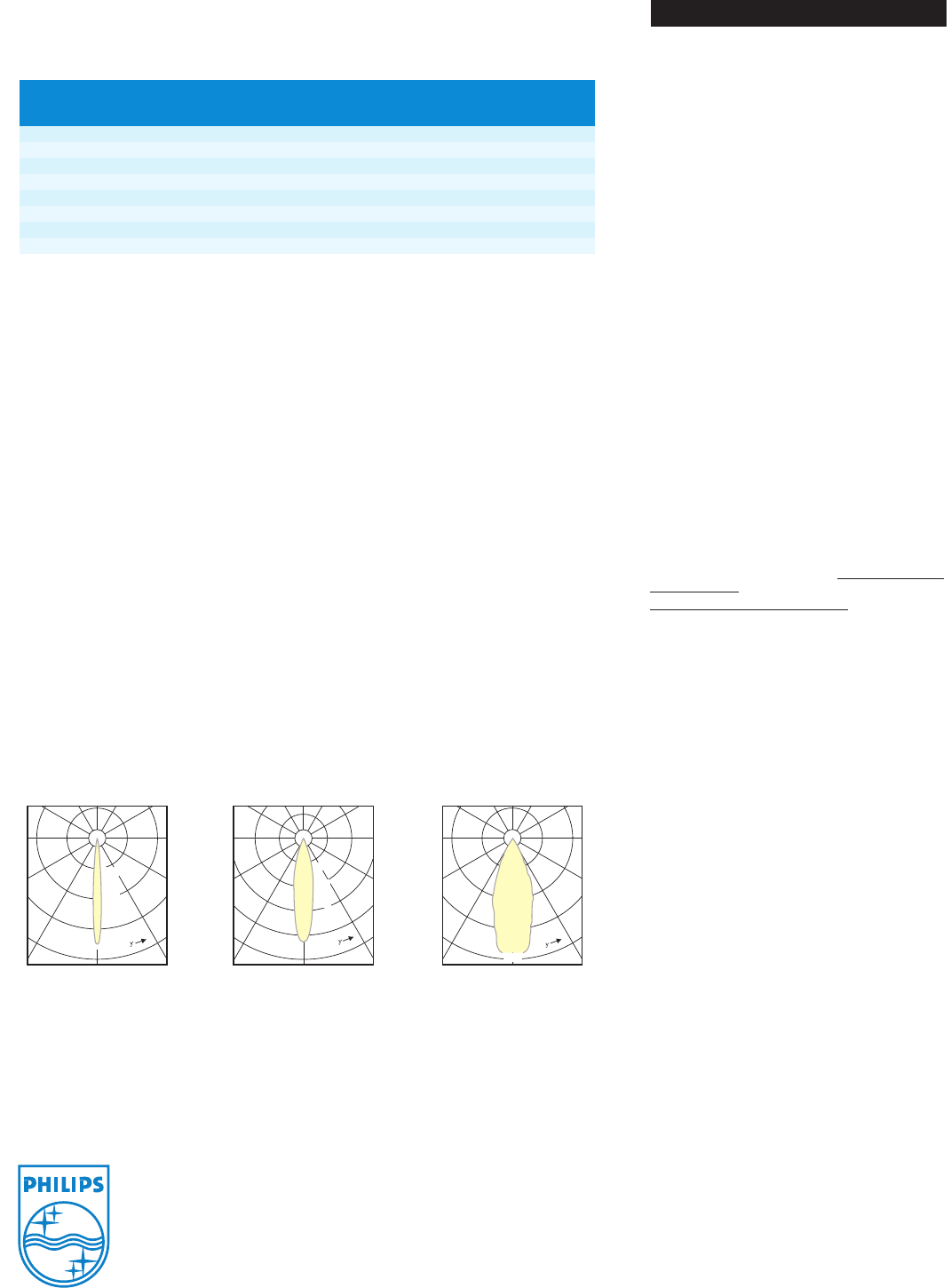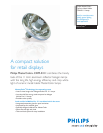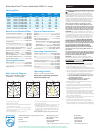
Polar Intensity Diagram
(
c
d
)
0°
(
c
d
)
0°
(
c
d
)
0°
180°
30°
60°
90°
30°
60°
90°
30°
60°
90°
30°
60°
90°
30°
60°
90°
30°
60°
90°
120°120°
Polar Intensity Diagram
180° 120°120°
Polar Intensity Diagram
180° 120°120°
40000
6000
4000
8000
10000
1000
2000
3
000
4000
2000
1
0000
20000
30000
CDM-R111
Philips MasterColor
®
Ceramic Metal Halide CDM-R111 Lamps
Ordering Data
Approx. Approx.
Product Nom. Beam Initial Mean
Number Ordering Code Watt. MBCP
1
Angle
2
Lumens
3
Lumens
4
1
5297-4 CDM-R111 20W/830 10DG 22 20,000 10˚ 750 500
2
0882-7 CDM-R111 20W/830 24DG 22 4500 24˚ 750 500
1
3554-1 CDM-R111 35W/830 10DG 38 35,000 10˚ 1400 900
1
3556-6 CDM-R111 35W/830 24DG 38 8500 24˚ 1600 1040
13921-2 CDM-R111 35W/830 40DG 38 4000 40˚ 1800 1170
14754-6 CDM-R111 70W/830 10DG 70 50,000 10˚ 2850 1850
14755-3 CDM-R111 70W/830 24DG 70 15,000 24˚ 2850 1850
1
4795-8 CDM-R111 70W/830 40DG 70 9000 40˚ 2850 1850
W
ARNINGS,CAUTIONSAND OPERATING INSTRUCTIONS
R
“
WARNING:These lamps can cause serious skin burn and
e
ye inflammation from short wave ultraviolet radiation if
o
uter envelope of the lamp is broken or punctured. Do not use
where people will remain for more than a few minutes unless
adequate shielding or other safety precautions are used. Certain
lamps that will automatically extinguish when the outer envelope
is broken or punctured are commercially available.”This lamp
complies with FDA radiation performance standard 21 CFR
subchapter J. (USA:21CFR 1040.30 Canada:SOR/DORS/80-381)
I
f the outer bulb is broken or punctured, turn off at
o
nce and replace the lamp to avoid possible injury from
h
azardous short wave ultraviolet radiation.Do not scratch
t
he outer bulb or subject it to pressure as this could cause
t
he outer bulb to crack or shatter. A partial vacuum in the
o
uter bulb may cause glass to fly if the envelope is struck.
WARNING:The arc-tube of metal halide lamps are designed to
operate under high pressure and at temperatures up to 1000˚ C and
can unexpectedly rupture due to internal or external factors such as
a
ballast failure or misapplication.If the arc-tube ruptures for any
r
eason,the outer bulb may break and pieces of extremely hot glass
m
ight be discharged into the surrounding environment.If such a
r
upture were to happen,THERE ISA RISK OF PERSONAL
I
NJURY,PROPERTY DAMAGE,BURNSAND FIRE.These
l
amps are designed to retain all the glass particles shouldan
arc tube rupture occur.The following operating instructions
are recommended to minimize these occurrences.
RELAMP FIXTURESAT OR BEFORETHE END OF
R
ATED LIFE.Allowing lamps to operate until they fail is
not advised and may increase the possibility of inner arc
tube rupture.
T
his lamp contains an arc tube with a filling gas containing
l
essthan 10 nCiof Kr-85 andis distributedby Philips Lighting
Company,a division of Philips Electronics NorthAmerica
Corporation,Somerset,New Jersey,08875.
CAUTION:TO REDUCETHE RISK OF PERSONAL INJURY,
PROPERTY DAMAGE,BURNSAND FIRE RESULTING FROMAN
ARC-TUBE RUPTURETHE FOLLOWING LAMP OPERATING
I
NSTRUCTIONS
M
UST BE FOLLOWED:
LAMP OPERATING INSTRUCTIONS:
1.RELAMP FIXTURES AT OR BEFORETHE END OF RATED LIFE.
Allowing lamps to operate until they fail is not advised and may
increase the possibility of inner arc tube rupture.
2.Before lamp installation/replacement,shut power off and allow lamp
and fixture tocoolto avoidelectrical shockandpotential burn hazards.
3.Use only auxiliary equipment meeting Philips and/orANSI standards.
Use within voltage limits recommended by ballast manufacturer.
A.Operate lamp only within specified limits of operation.
B.Fortotalsupply load refer toballast manufacturers electricaldata.
C.Operate 39W PAR-20 and PAR-30L lamps only on
thermally protected ballast.
D.Operate CDM-R111 lamp only on approved
thermally protected electronic ballast.
4.Periodically inspect the outer envelope.Replace any lamps that
show scratches,cracks or damage.
5.If a lamp bulb support is used,be sure to insulate the support
electrically to avoid possible decomposition of the bulb glass.
6.Protect lamp base,socket and wiring against moisture,corrosive
atmospheres and excessive heat.
7.Time should be allowed for lamps to stabilize in color when turned
on for the first time.This may require several hours of operation,
with more than one start. Lamp color is also subject to change
under conditions of excess vibration or shock,and color appearance
may vary between individual lamps.
8.Lamps may require up to 10 minutes (4–8 minutes for CDM-R111)
to re-light if there is a power interruption.
9.Take care in handling and disposing of lamps. If an arc tube is
broken,avoid skin contact with any of the contents or fragments.
10.For proper installation and removal,lamp should be handled by the
sides of the reflector and not by the aluminum front anti-glare cap.
Electrical and Technical Data
L
amp OperatingVolt.(rms)(Nom.)
5
–
–––––100 (20W)
–––––––––––––––––––––––––––––––––––88 (35W)
–––––––––––––––––––––––––––––––––––83 (70W)
I
nitial LampVolt.Range (rms)
6
–
–––––––96-109 (20W)
––––––––––––––––––––––––––––––––80-100 (35W)
–
––––––––––––––––––––––––––––––––78-87 (70W)
L
amp Operating
Current (Amps) Nominal (rms) ––––––––0.22 (20W)
–
–––––––––––––––––––––––––––––––––0.53 (35W)
––––––––––––––––––––––––––––––––––0.88 (70W)
Lamp Current Crest Factor (Maximum)–––––––––1.8
Warm-up to 80% Full Brightness –––––––––3 minutes
RestrikeTime for Hot Lamps ––––––––– 4–8 minutes
Ballast Open CircuitVoltage –––––––––198 RMS Min.
Pulse PeakVolts––––––––––––––––––––––3000-4000
PulseWidth @ 90% Peak–––––2 Micro Sec.Minimum
Pulse Repetition Rate (Minimum)
7
–––1 per Half Cycle
Minimum OperatingTemp.––––––––––– -30˚C (-22˚F)
Ordering Information
ANSI Designation ––––––––––––––––––C175 (20W)
–––––––––––––––––––––––––––––––M130/O (35W)
–––––––––––––––––––––––––––––––M139/O (70W)
Package Quantity ––––––––––––––––––––––––––––6
Physical Characteristics
B
ulb Size––––––––––––––––––––––––––––––––R111
B
ulb Finish––––––––––––––––––––FacetedAluminum
B
ase ––––––––––––––––––––––––––––––––––GX8.5
M
ax.Overall Length (MOL) ––––––––––3.74'' (95mm)
M
ax.PermissibleTemperatures:
B
ase/NeckTransition – 180˚C (356˚F) (20W/70W)
–––––––––––––––––––––––150˚C (302˚F) (35W)
Neck/Reflector–––––––––––––––––200˚C (392˚F)
TopAnti-GlareTop –––400˚C (752˚F) (20W/70W)
–––––––––––––––––––––––350˚C (662˚F) (35W)
ArcTube Material ––––––––––PolycrystallineAlumina
Operating Characteristics
R
atedAverage Life,Hours.
8
–
––––––9000 (20W/70W)
––––––––––––––––––––––––––––––––11,000 (35W)
CRI ––––––––––––––––––––––––––––––––85 (20W)
–––––––––––––––––––––––––––––––––––81 (35W)
–––––––––––––––––––––––––––––––––––84 (70W)
Correlated ColorTemp.(CCT)
4
––––––––––––3000K
CIE ChromaticityApprox.
4
–––––x-.429,y-.395 (20W)
–––––––––––––––––––––––––––x-.433 y-.402 (35W)
–––––––––––––––––––––––––––x-.439 y-.393 (70W)
Efficacy (lpw)–––––––––––––––––––––––––34 (20W)
–––––––––––––––––––––––––––––––––––37 (35W)
–––––––––––––––––––––––––––––––––––41 (70W)
Operating Position
Universal — Open or Enclosed Luminaire
Note: Use on thermally protected
electronic ballast only.
© 2007 Philips Lighting Company.All rights reserved.
Printed in USA 06/07
P-5673-C
www.philips.com
Philips Lighting Company
200 Franklin Square Drive
P.O.Box 6800
Somerset,NJ 08875-6800
1-800-555-0050
A Divisionof PhilipsElectronics NorthAmericaCorporation
Philips Lighting
281 Hillmount Road
Markham,Ontario
Canada L6C 2S3
1-800-555-0050
A Divisionof PhilipsElectronics Ltd.
1) MaximumBeam Candlepower
2) BeamAngleat 50%of MBCP
3)Measured at 100 hrs.life.Approximate lumenvalueslistedare
forverticaloperationof thelamp.
4)Approximate lumenoutputat 40%of lamp rated averagelife.
5) Measured atrated lamp watts on alinear reactor.LPW does
not include ballast losses.
6) Measured with the lamp operating at rated watts.
7) Option-PulseWidth @ 90% Peak,1 micro second minimum
with 2 pulses per half cycle.
8)Ratedaveragelifeis thelifeobtained,on theaverage,from large
representative groups of lampsin laboratory tests under
controlled conditionsat 10or more operating hours per start.
It is basedon survivalof atleast 50%of thelamps andallows
forindividuallamps or groups of lampsto vary considerably
fromthe average.
Above specifications subject to change without notice.
CDM-R111 35W 10DG CDM-R111 35W 24DG CDM-R111 70W 24DG
Polar Intensity Diagram
Beam spread at 50% Maximum Beam
Candlepower — 0˚ PrimaryAngle
Printed on chlorinefree paper from Sappi FinePaper mills,who are accreditedwith EMAS environmentalcertification.
Sappi claims that the pulp used in the manufacture ofMagno Dull paper is derived from environmentally certified forests.




